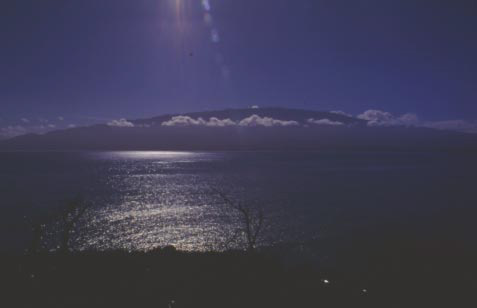Alpine/Aoelian » Unit 2: Summer Every Day and Winter Every Night » Activity 2: Mauna Lei Mystery
Instructions
Class Period One
1) Show the He Lei Keakea acetate to the class and read the Hawaiian chant, or have one or all the students read it. Then read the English translation and ask students whether they have ever noticed this lei of clouds around Haleakalā. What do they think causes it?
2) Divide the class into groups of four to six and pass out the Student Pages “Solving the Mauna Lei Mystery.” Allow groups to work together to explain the regular formation of the “cloud lei” around the upper slopes of Haleakalā, using the clues provided.
Teaching Option
If you prefer that your students work with graphs instead of data tables, substitute the four graphs and one table in the “Optional Graphs for Solving the Mauna Lei Mystery” (master, pp. 12-16) for data tables 1-5 in the Student Page “Solving the Mauna Lei Mystery.” Have students use these graphs instead of the tables to fill in the Climate Conditions Clues Summary Table (p. 18).
3) If students are having difficulty working through the clues, you may want to prompt them with questions. For the Climate Conditions Clues (pp. 18-21), these questions may be helpful:
- Looking at the grid, how would you characterize the climate at each of the five elevations?
- Which of the climatic conditions do not change in a linear fashion according to the elevations? What do you think might explain unexpected changes in conditions at the middle elevations?
For the Global Forces Clues (pp. 22-24), these questions may help:
- What happens to moisture in the air as the air cools or is under less pressure?
- It’s generally true that “hot air rises,” but is there any evidence that a warmer air mass may be found on top of cooler air in the atmosphere?
- What effect would a layer of warmer air over cooler air have on cloud formation?
Class Period Two
1) Group by group, have students present their findings to the class, explaining how they resolved the mauna lei mystery and what evidence and reasoning they used to support their conclusions. Either have each group present its answers to all the questions posed on the student sheet, or ask different groups to cover each question in turn.
2) Culminate the discussion by asking the final question posed on the student page, “What are the main climatic conditions and patterns within the alpine/aeolian zone?” Ask students to consider what living conditions are like for plants and animals that live in the alpine/aeolian zone, and to compare them to likely conditions on other parts of Haleakalā.
Journal Ideas
- There is a weather phenomenon known as a Kona storm that occasionally occurs in the Hawaiian Islands. These spectacular winter storms are associated with strong winds from the south that bring large amounts of rain. When Kona storms hit Haleakalā, maximum rainfall generally falls at the summit, and rainfall decreases with elevation. Where do you find evidence of Kona storms on Table 5 of the Student Page “Solving the Mauna Lei Mystery”? Explain your answer and hypothesize about how a strong season of Kona storms might skew other climate data you have been working with in this activity.
- In addition to the mauna lei, what other weather phenomena can you think of that seem to have regular daily patterns of change?
- Ancient Hawaiians did not live in the summit area of Haleakalā, which is a sacred place in Hawaiian tradition. What would it have been like for early Hawaiians to visit the summit area? How might they have protected themselves from climate extremes without modern technology?
Assessment Tools
- Student Page “Solving the Mauna Lei Mystery” (teacher version, pp. 9-10)
- Cooperation and participation in group work
- Team presentations: Evaluate on the basis of reasoning, clarity, and accuracy of the presentation, and completeness.
- Journal entries
Media Resources
- None.

